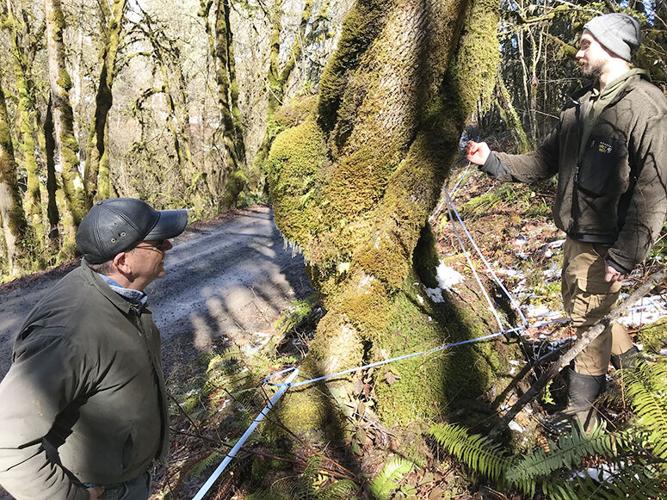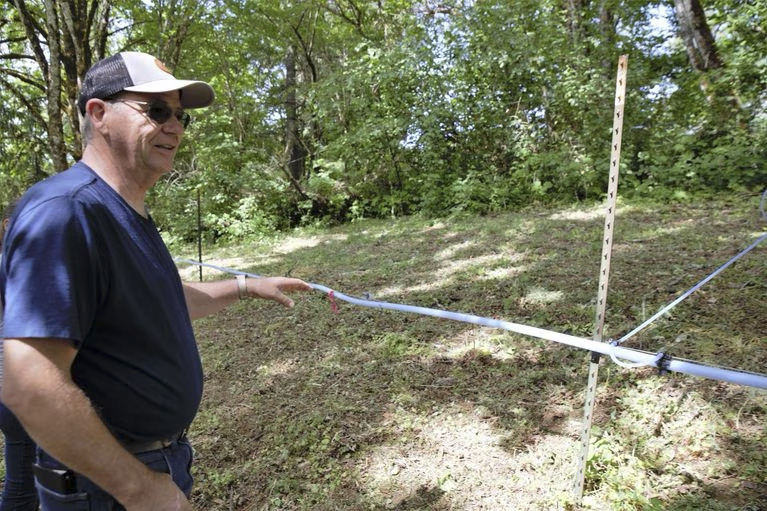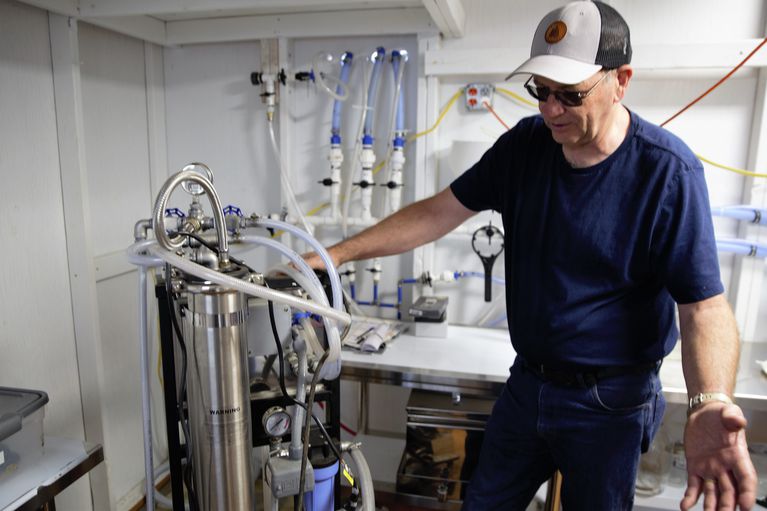Western Innovator: Tapping into potential of bigleaf maples
This is a re-post from Capital Press By MATEUSZ PERKOWSKI
SHERIDAN, Ore. — Nothing much was ever expected from the bigleaf maple trees that dominate about 10 acres of Dan Caldwell’s property near Sheridan, Ore.
Aside from diversifying his forestland, he assumed they lacked any commercial value.
“When they logged the area years ago, they didn’t actually kill the maple trees,” Caldwell said. “Up until this year, I thought they were worthless.”
That changed when he was doing some roof work for his neighbors, Tracy Johnston and Gary Pendergrass, and found out they’d been tapping their maple trees for syrup for a couple of years.
Joint effort
The neighbors are now working together to harvest sap and produce syrup, hoping to cultivate a new source of income to complement their existing businesses.
This winter, they’ve collected sap from about 365 maple trees between their two properties, refining the process with an eye toward eventual syrup sales.
Johnston and Pendergrass operate a vineyard and sell components for log home construction.
Before learning the Northwest’s bigleaf maples can produce the tasty condiment, the married couple had likewise been indifferent toward them.
“We never paid attention to our maple trees,” Johnston said.
For Caldwell, who works as a handyman, the venture offers a potential financial opportunity in which he can involve his children and grandchildren.
“I was looking for something that I can start as a generational business,” he said. “It’s something I can pass down to the next generation, to keep it going.”
Johnston and Pendergrass are considering how to best market the syrup, which they’ve been giving out as samples, and examining whether the concept will pencil out.
“We’re trying to determine what’s viable for us,” Pendergrass said. “You’ve got to determine a price point that will make you a buck, then see if people will buy it.”
If the idea proves worthwhile, surrounding landowners may decide to lease their trees to be tapped for sap as well, Caldwell said. “Once we maximize what we have on site, we can branch out to other people.”
OSU help
They’ve been helped along the way by researchers from Oregon State University, who are trying to build maple syrup production into a new Northwest agricultural sector.
“The idea behind the project is to develop commercial uses for the bigleaf maple trees on the West Coast,” Johnston said. “The goal is not just to explore maple syrup but other maple tree products.”
For example, bigleaf maples have edible blossoms, and their fresh branches can be cut for livestock hay.
Though there’s no shortage of maple trees in the Northwest, syrup production has never been commercialized on a large scale in the region, as it has in New England and Canada.
That’s partly due to the age-old heritage of tree-tapping in the Northeast, where early European colonists emulated Native American syrup-making techniques, said Eric Jones, an OSU assistant professor who’s leading the maple syrup project.
“The tribes taught them to make syrup. That history goes way back,” he said.
Less sugar
The East Coast’s sugar maples also have two to three times more sugar in their sap than do the Northwest’s bigleaf maples, Jones said.
The lower sugar levels in bigleaf maples means that roughly two to three times more water must be removed from their sap to make syrup.
Water content was traditionally reduced through boiling, requiring too much expensive energy for bigleaf maple sap to be processed economically.
Better technology
With advances in technology, however, water levels can now easily be decreased with reverse osmosis equipment that functions like water purifiers for household use.
Instead of eliminating contaminants, the reverse osmosis process increases the sap’s sugar content while separating out roughly 70% of the water, which can be used for washing or other purposes.
After that, the sap must still be boiled to make syrup but the energy cost is substantially diminished.
Sap collection has also progressed from the time when buckets where hung from spiles inserted into the trees.
Nowadays, the sap runs through the spiles into tubes, pulled from the trees by pumps that carry it into large vats.
“All the tubes are going downhill, otherwise we’re fighting gravity,” said John Scheb, an OSU graduate student who’s helping with the project for his capstone report.
Once enough sap accumulates, it’s concentrated through reverse osmosis, frozen for storage, and eventually turned into syrup inside the “sugar shack” on Johnston and Pendergrass’ property.
Temperature matters
Trees release the most sap when temperatures drop below freezing at night and rise above it during the day.
“Some days, it runs hot and heavy,” Caldwell said.
The fluctuations are still somewhat mysterious, but it’s likely the tree pulls sap into its limbs to protect against frost and then sends it back to its roots.
In tapped trees, about 1% of the sap is harmlessly released through the spiles. If the sap stops running for too long, the bark heals and new holes must be drilled.
Syrup terroir
Thousands of gallons of sap were harvested this winter on the properties, but that will yield only about 10 gallons of syrup.
The sap-to-syrup ratio is one reason Caldwell isn’t worried Northwest landowners will quickly generate a massive surplus, as has occurred with hemp and other farm products.
“This is hard to overproduce,” he said.
Because Northwest syrup production is starting at a small scale, producers can also capitalize on the subtle flavor differences across the landscape, similar to the “terroir” in wine.
Instead of processors homogenizing the product, which is common in major production areas, Northwest syrups could retain the taste unique to their location, said Scheb.
“That’s the beauty of here, is you get more of a craft industry with a variety of flavors,” he said.
Though the Northwest will probably “always be a bit more boutique” than the Northeast, that can work to the region’s advantage, Jones said. Just as microbrews are spendier than Budweiser, bigleaf maple syrup commands a higher price point.
Top-shelf sugar maple syrup from New England costs about $100 per gallon, while the small amount of commercially available Northwest bigleaf maple syrup sells for three times that, he said.
That gap may shrink as volumes grow, but bigleaf maple syrup is likely to continue receiving a premium, Jones said.
“It looks promising to always be a higher value,” he said.
Bigleaf maple syrup contains three times as much calcium, potassium and other minerals as conventional maple syrup, Jones said. Those nutrients convey a “more complex, richer flavor” that consumers have preferred in formal tastings conducted by OSU.
USDA funding
The university’s bigleaf maple project is funded with $1 million from a USDA grant program to promote domestic syrup production, which has paid for the pumps, tubing, evaporator and refining equipment being tested by Caldwell, Johnston and Pendergrass.
Landowners who are interested in the budding industry are invited to attend the Oregon Bigleaf Maple Festival, scheduled for May 13 at the Oregon 4-H Center in Salem, Ore.
As the industry gains its legs, it’s likely to provide an economic boost not only to syrup producers but to equipment distributors and other ancillary businesses in the region, Jones said.
“I think it could develop over the next couple decades to be on par with the blueberry industry,” he said. The USDA values annual blueberry sales at $400 million in Oregon and Washington.
“This is just the beginning,” Jones said. “We have a long way to go.”



